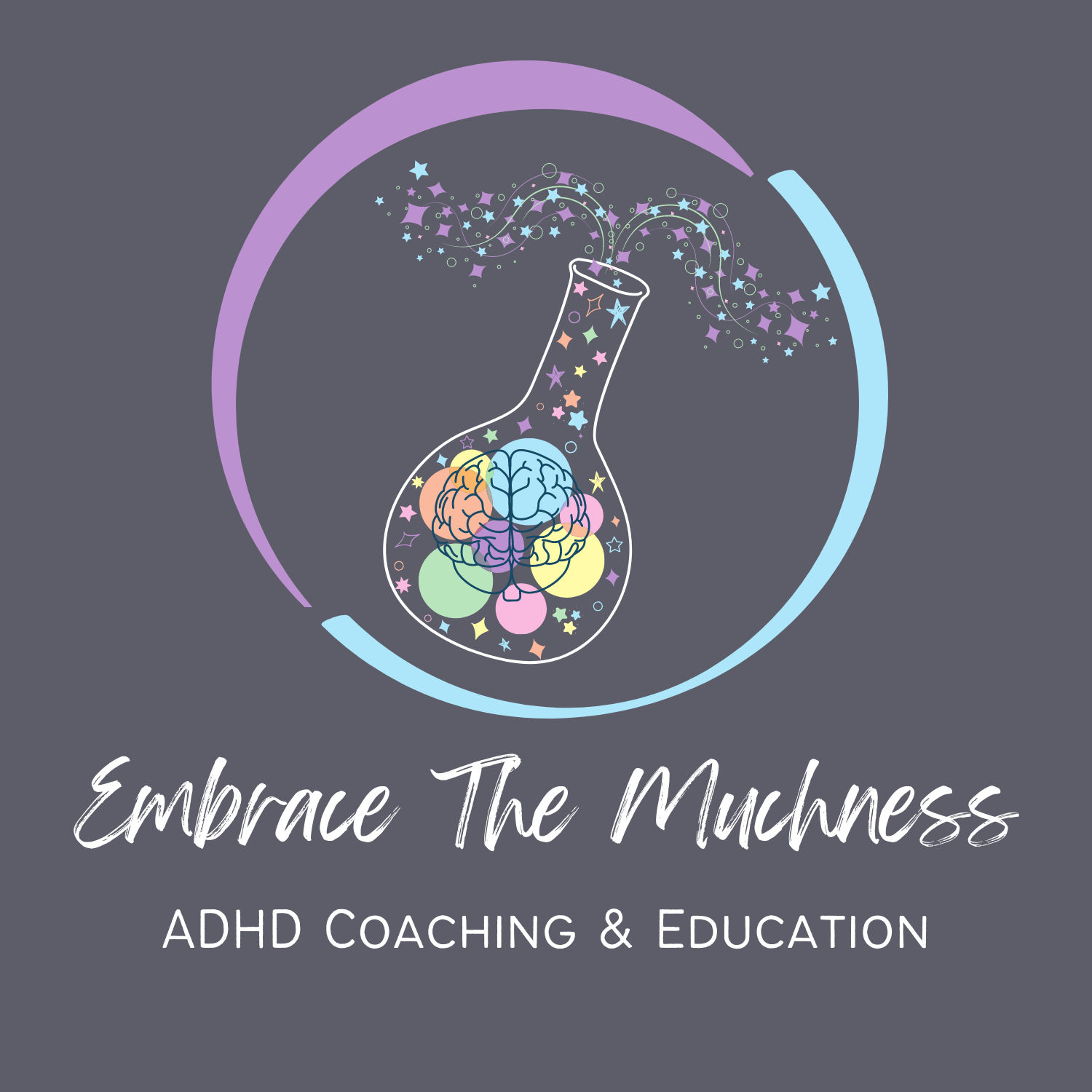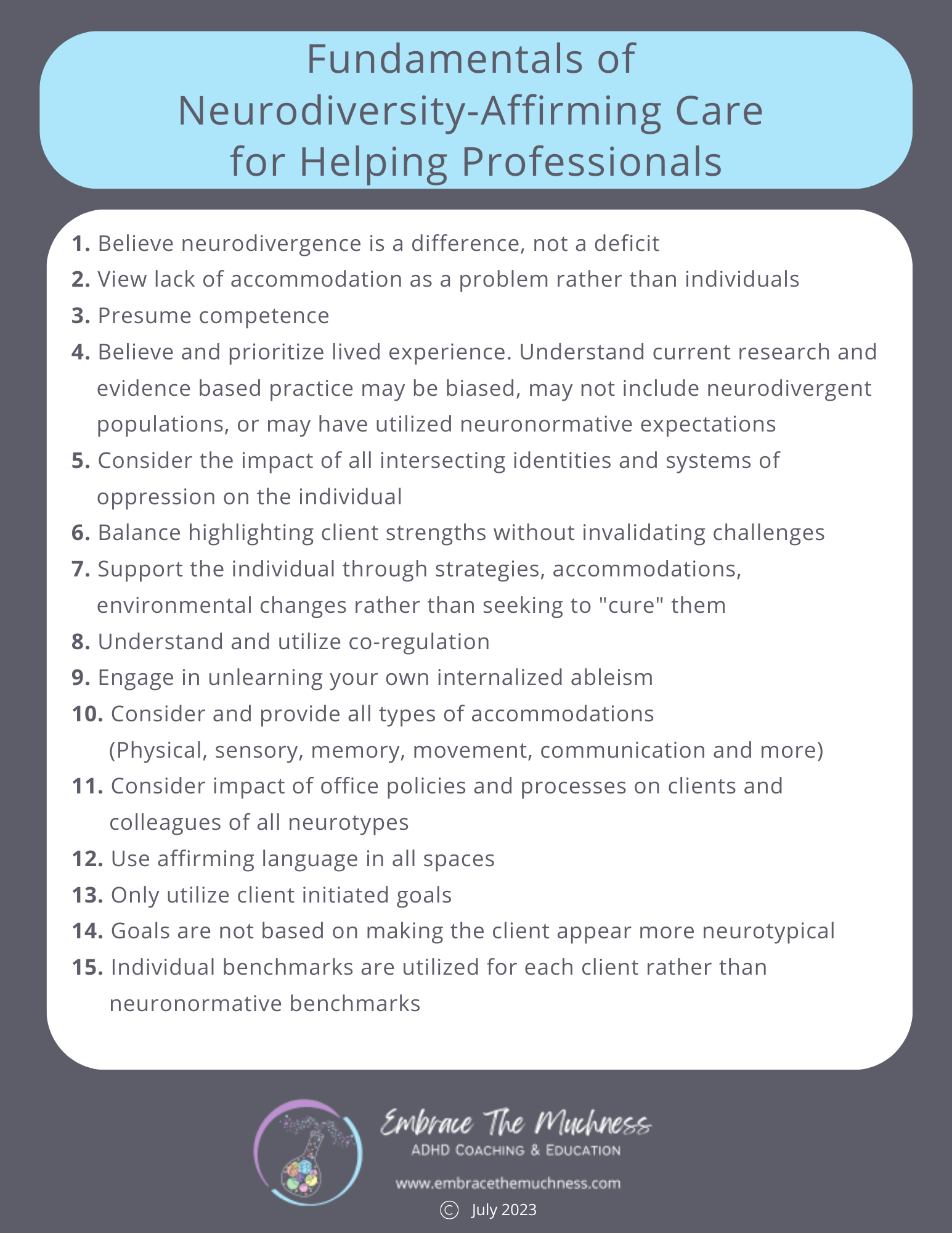A Guide to Becoming a Neurodiversity-Affirming Helping Professional
The neurodiversity movement has gained more visibility in recent years, which means that many neurodivergent individuals are seeking providers (therapists, psychiatrists, psychologists, coaches, social workers, doctors and other medical professionals, etc.) who ascribe to a neurodiversity-affirming approach to their work. Some people refer to this approach as neuro-affirming or neurodivergent affirming as well and while a part of me could write a long discussion about the differences and merits of each term, for now, let’s just assume they all have the same underpinnings.
There might be a part of you that recognizes the medical model approach to providing support to neurodivergent individuals just doesn’t feel quite right and can leave clients constantly feeling like there’s something “wrong” with them. Neurodiversity-affirming care prevents unintentional harm to clients since it centers the individual client’s experience and goals. Traditional approaches can harm neurodivergent clients when they are built on an underlying assumption that the goal is to do things “like everyone else.” While being able to do things like others may seem like it would reduce struggles for the individual, many neurodivergent people will not be able to communicate, feel, manage time, organize, etc. the same as others do. This leads to hopelessness, shame, feeling like they’ve failed therapy, or what’s called “masking”. Masking occurs when a neurodivergent person attempts to hide their natural traits by attempting to do things in the way that others do, but it never feels natural and takes a large amount of effort. Masking drains the individual’s energy and can lead to burnout. Following a neurodiversity-affirming approach means you help clients in a way that honors both their strengths and challenges and allows for discussion of differences in a neutral way. If you’re ready to explore what it means to be neurodiversity- affirming you can follow these steps to dive down that rabbit hole.
Step 1: Educate Yourself
If you are new to understanding the neurodiversity paradigm, check out my previous blog titled, “What is neurodiversity?” to help get you started. I also recommend checking out my ADHD/Neurodiversity Glossary which is free to all newsletter subscribers as a thorough reference resource. There’s a lot of jargon that’s used in this world and so being familiar with all the terms and concepts is essential. It’s important to name that since there are a myriad of neurotypes that fall under the neurodivergent umbrella, that it’s impossible to know everything about the experiences of each one. For example, my specialty and personal experience is around ADHD. This is what led me to finding a neurodiversity affirming approach, but I now apply the principles of a neurodiversity affirming approach to ALL CLIENTS that I work with, regardless of neurotype. To begin this work, you simply need a foundation of understanding the underpinnings of the neurodiversity paradigm, then you can shift into how we apply those concepts to your work.
Step 2. Understand the Fundamentals of a Neurodiversity-Affirming Approach
Once you’ve got an understanding of the underpinnings of the neurodiversity paradigm, we can then translate it to practice. I’ve created a list of 15 Fundamentals of a Neurodiversity-Affirming Approach for Helping Professionals. This list was created from:
observations from neurodivergent individuals on what was helpful and unhelpful for them (through my own work as a therapist and ADHD Coach supporting ADHDers and from online neurodivergent community discussion boards)
the work of neurodiversity advocates
my personal experience of what I my ideal care would look like as an ADHDer
Fundamentals of a Neurodiversity-Affirming Care for Helping Professionals
1. Believe neurodivergence is a difference, not a deficit
2. View lack of accommodation as a problem rather than individuals
3. Presume competence
4. Believe and prioritize lived experience. Understand current research and evidence based practice may be biased, may not include neurodivergent populations, or may have utilized neuronormative expectations
5. Consider the impact of all intersecting identities and systems of oppression on the individual
6. Balance highlighting client strengths without invalidating challenges
7. Support the individual through strategies, accommodations, environmental changes rather than seeking to "cure" them
8. Understand and utilize co-regulation
9. Engage in unlearning your own internalized ableism
10. Consider and provide all types of accommodations (Physical, sensory, memory, movement, communication and more)
11. Consider impact of office policies and processes on clients and colleagues of all neurotypes
12. Use affirming language in all spaces
13. Only utilize client initiated goals
14. Goals are not based on making the client appear more neurotypical
15. Individual benchmarks are utilized for each client rather than neuronormative benchmarks
I’ve created a printable version for you that can be downloaded!
Step 3: Actively Embody the Fundamentals
Once you understand the fundamentals from a theoretical perspective, it’s time to begin the work of actively embodying them. This can be long and arduous work. It entails looking at each one of these fundamentals and challenging yourself on your practices and internal through processes. In order to engage in this type of work, you need to stay aware of the parts of yourself that may feel defensive and will need to be able to approach the work with openness, curiosity and compassion.
Our society is ripe with ableism and I believe the general population is still on the front end of understanding what ableism even means. It’s so entrenched that oftentimes we don’t even know that a belief that we hold or a policy we have in place is ableist. I highly recommend getting feedback directly from neurodivergent individuals about your practices.
One way to do this is to pay a neurodivergent consultant to do a walk through of seeking services with you. They would follow all processes for initiating services, and may even attend an initial session posing as a new client and would note any experiences in your processes that felt unclear, unwelcoming or challenging for them. Then they would share feedback with you and any suggestions for improvement.
Another option is during your intakes to invite clients to give you feedback on what’s working for them or not. After a couple of sessions, take time to check in on their overall experience and anything they’d like you to do more or less of, or any other accommodations that might help them. When they share feedback, you may want to consider if this is an individual preference, or if it’s worthwhile to consider making a change for all clients.
It’s not possible for us to anticipate every challenge a client may face while accessing services with us, but encouraging, listening to, and responding to feedback from clients of various neurotypes can help us continually grow.
Step 4: Review Your Marketing
Once you’ve taken steps to actively embody all of the fundamentals of a neurodiversity-affirming approach, it can be helpful to review how all marketing of your business is worded to convey you use a neurodiversity-affirming approach. Because embodying everything laid out in step 3 is an ongoing, long term process, you won’t exactly be able to check a box that it’s all completed before you can move on to updating marketing, but I personally believe it’s best for clients if you’ve begun actively engaging in Steps 1-3.
There are individuals and businesses who know that neurodiversity language is “trending” and so they utilize language (often incorrectly) from the neurodiversity paradigm but are not actually putting in the work to follow all the steps laid out here. This creates harm for clients as they will look for providers using neurodiversity language but then experience support measures that are harmful. This happens so frequently, that one of my next blogs will focus on tips for how to find a neurodiversity affirming provider.
Step 5: Engage in Focused Learning
Neurodiversity is broad, so there’s tons of specific rabbit holes you can go down to keep learning more. I suggest starting with a specialty area that is interesting to you and feels most pressing for the clients you work with. For example, I offer a training called “A Deep Dive into Adult ADHD: A Neurodiversity Affirming Approach for Mental Health Professionals” that provides both an overview of neurodiversity affirming care, a deep dive into the adult ADHD experience, suggested adaptations to practice, and a framework for working with adult ADHD.
As you do this work, themes will become clear about where to direct your learning next. One of my favorite neurodiversity related social media content creators @neurowild has created a Knowledge Tracker Iceberg that provides both ideas to direct your learning and a fun way to track it!
Step 6: Engage with Community
Whether you are working on your own, or in a group/agency, you may not readily have support available from people who are already working from a neurodiversity affirming framework. Without support, you can feel lonely and might question if you are “doing this right”. If working in agency settings you may even feel pressure to conform to a different approach. A passive option to engage with the neurodiversity-affirming community is following content creators; whether that’s through subscribing to newsletters, reading articles from certain websites, listening to podcasts, or following accounts on social media, this can help you feel like you aren’t in this effort alone. (My ADHD Resource List gives suggestions) A slightly more active approach is joining online groups with individuals who practice from a similar approach. The nice thing about joining an online group is you can choose to quietly observe and read others posts and responses, or can be more actively engaged. You can also participate in professional consultation to be able to ask direct questions and get support either individually or in a group setting.
If you are ready to get started you may find these resource lists as a helpful starting point:
ADHD Resource List - Professional Development Around ADHD
Neurodivergence Therapy Trainings - Compiled by Dr. Christine Henry
The journey to become a neurodiversity-affirming provider may feel daunting at first but can be broken down into more tangible steps. In the end, it is extremely rewarding to hear clients say things to you like “I’ve got more from 1 session with you then I did from 2 years with my previous provider.” Ultimately, by embracing these steps, providers contribute to fostering a culture of acceptance and empowerment that benefits neurodivergent individuals and society at large.

